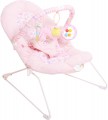Weight limit
The maximum weight of a child that the swing can support without negative consequences in any position and in any mode of operation. A heavier child should not be placed: even if it does not break immediately, there is no guarantee that this will not happen at some point later, with unpleasant consequences for the child.
Backrest tilt adjustment
Possibility
of adjusting the backrest tilt of a swing. This adjustment is separate from the seat and provides the possibility to adjust the entire seat unit for both sitting and lying positions; in bouncers, the backrest tilt adjustment is performed simultaneously with the seat (see "Seat tilt adjustment").
Backrest tilt levels
The number of fixed positions in which the adjustable backrest of the swing can be installed (refer to "Backrest tilt adjustment"). Any adjustable backrest has at least two positions — lying and sitting, and the more levels of tilt — the more options you have for customizing the swing to maximize your baby's comfort.
Headrest/seat pad
The presence in the delivery set of
a special pad placed on the seat. It can be a headrest mounted on the back, an insert on the seat, or a two-in-one. Its main purpose is to provide maximum comfort for the baby, especially in the first months of life. In addition, the pads can be made removable, which makes it easier to clean the swing.
Carrying handles
Special
handles that make it easier to carry the swing. Usually they are fabric straps — they are quite comfortable and take up a minimum of space when not in use.
More features
—
Timer. A timer that switches off the automatic rocking mechanism (refer to "Automatic rocking") after a certain time. Thus, knowing the approximate time your baby falls asleep, you can set the timer and not worry about the rocker continuing to rock unnecessarily while your baby sleeps.
—
Removable table. The presence of a removable table top in the design of the swing. Such a swing can play the role of a high chair; in addition, the table top can be useful for games.
—
Player connection. A function similar to a music box (see above) — with the difference that the sound source is not the memory of the box itself, but a player connected to the swing.
—
Vibration unit. The mechanism that provides the vibration of the seat unit — this plays the role of a massage for the child, and also creates a relaxing effect.
—
Arc with toys. A structure in the form of an arc or bracket above a swing, on which various toys are suspended. They can be used to play or to distract the baby (for example, to stop crying). The arcs are often made removable, and the brackets are also swivel.
— Lighting effects. Multi-coloured flashing lights that can cheer up or distract the baby (especially in combination with sound).
Power supply
—
Mains. Power supply from the ordinary 230 V mains supply. Such power supply is as reliable as possible: there are no batteries that can die at the most unfortunate moment. On the other hand, the use of additional functions of such a rocker is limited by the availability of the network (in nature, for example, they will be useless) and the length of the power cord.
—
Batteries. Powered by replaceable elements. This gives maximum freedom of movement: the rocker does not depend on the power supply and the length of the cord, its additional functions can be used anywhere and anytime. On the other hand, batteries have a limited charge and need to be replaced from time to time, and ideally you should have a constant supply of new ones, as some functions consume their charge very quickly.
—
Mains/batteries. Combined power supply, which provides the advantages of both previous types: as long as there is a mains power supply nearby, the rocker is connected to it, saving battery power, and when there is no mains power supply or the outlet is too far away, batteries are used.

